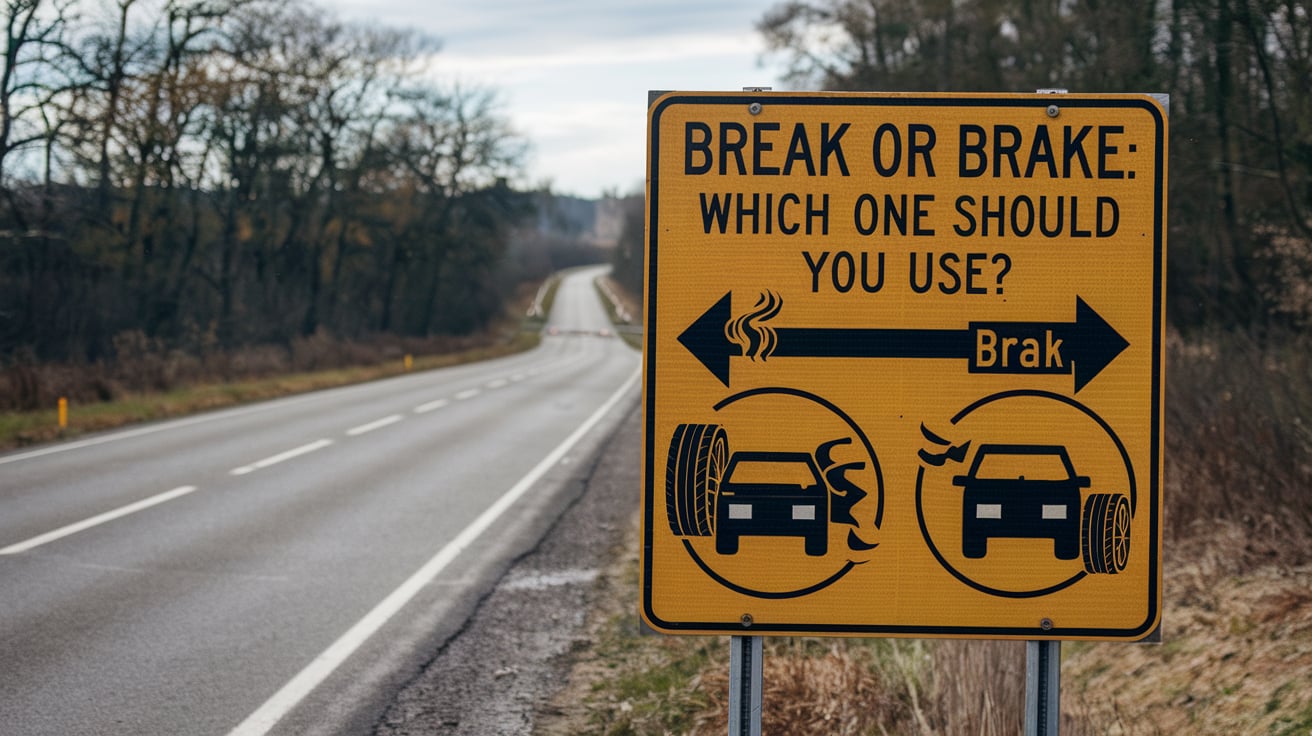Introduction
Understanding the difference between “break” and “brake” is essential for both effective communication and safety. Even though these two words sound alike, their meanings and applications are entirely different. Therefore, this article will explore their distinctions, provide practical examples, and highlight their relevance in everyday language and vehicle safety.
Understanding the Basics
What Does “Break” Mean?
The word “break” refers to an interruption, damage, or change in continuity. Consequently, it is often used in everyday language to describe pauses, disruptions, or physical harm.
Read More About This Article: Hooves or Hoofs: Which One Should You Use?
Common Definitions and Usage:
- Interruption or Pause: Taking a break from work or studies.
- Damage or Rupture: Breaking a glass or an object.
- Change in Continuity: A break in a routine or conversation.
Examples:
- “I need a short break to recharge.” (Pause or stop)
- “Be careful not to break the vase.” (Disruption or harm)
- “There was a break in the signal.” (Interruption)
Synonyms:
Pause, disruption, rupture, interruption.
What Does “Brake” Mean?
On the other hand, the word “brake” refers to a mechanical device designed to slow down movement or stop it entirely. As a result, it is commonly associated with vehicles and machinery.
Common Definitions and Usage:
- Mechanical Device: A tool that slows down or halts motion.
- Action of Decelerating: Applying brakes to reduce speed.
- Connection to Vehicle Safety: Essential for driving and traffic safety.
Examples:
- “Press the brake gently to stop the car.” (Vehicle safety)
- “The cyclist applied the brake to avoid a collision.” (Decelerating action)
- “Modern cars have advanced braking systems for safety.” (Mechanical equipment)
Synonyms:
Decelerating tool, slowing mechanism, retardation device.
Key Differences Between “Break” and “Brake”
Functional Distinctions
| Aspect | Break | Brake |
|---|---|---|
| Definition | Interruption, pause, or damage | Mechanical device for slowing |
| Context | Everyday activities, damage | Vehicles, machinery |
| Action/Tool | Action of disruption | Tool for deceleration |
Contextual Usage
To clarify, understanding the sentence context is crucial for differentiating between the two. For instance:
- “Take a break after completing the task.” (Pause)
- “Apply the brake to stop the car.” (Mechanical device)
Usage in Everyday Language
Common Usage of “Break”
“Break” is frequently used in various scenarios, from work pauses to physical damage.
Examples:
- “Let’s take a break after this meeting.” (Rest or pause)
- “The glass might break if dropped.” (Disruption or harm)
Idiomatic Expressions:
- Break the ice: To initiate a conversation in a friendly manner.
- Break a leg: A way to wish someone good luck.
- Break new ground: To start something innovative.
Common Usage of “Brake”
“Brake” is more technical and relates primarily to vehicle safety and machinery.
Examples:
- “The truck’s brakes need servicing for better car security.”
- “He used the brake to slow down on a steep hill.”
Everyday References:
- “Brake failure can lead to accidents.” (Road safety)
- “Check the braking system before a long trip.” (Automotive safety)
Practical Examples and Sentence Context
| Sentence Context | Break Example | Brake Example |
|---|---|---|
| Daily Routine | “I need a break after lunch.” | “Apply the brake to stop the car.” |
| Emergency Situation | “The machine might break!” | “The brake isn’t working!” |
| Idiomatic Usage | “Don’t break the rules.” | “Always test the brake first.” |
Scenarios for Clarity
- Driving Safety: Misusing “break” instead of “brake” could cause confusion in instructions, such as “Apply the brake” during an emergency.
- Writing About Taking Pauses: While discussing breaks, remembering the distinction prevents grammatical errors.
Importance in Vehicle Safety
The Role of Brakes
Braking systems are essential for modern vehicles and contribute significantly to driving safety.
Types of Brakes:
- Disc brakes
- Drum brakes
- Anti-lock braking systems (ABS)
Facts About Vehicle Brakes:
- The average car’s braking distance at 60 mph is about 240 feet.
- Regular maintenance prevents brake wear and failures.
Safety Implications
Miscommunication regarding brakes can be life-threatening. Therefore, always ensure accurate communication, especially during emergencies.
Tips to Remember the Difference
Mnemonics:
- “You break something; you use brakes to stop.”
- “A car’s brake slows; a coffee break refreshes.”
Practice Sentences:
- “Don’t let the system break under pressure.”
- “Press the brake pedal firmly to stop the vehicle.”
Broader Implications of Misuse
Professional Communication
Misusing “break” and “brake” in technical writing can harm credibility. For example, ensuring precision in manuals, such as braking system guides, is critical.
Creative Writing
When writing about rest or disruptions, choosing the correct word maintains clarity.
Example:
- Incorrect: “The vehicle’s break failed.”
- Correct: “The vehicle’s brake failed.”
Conclusion
Understanding the difference between “break” and “brake” is crucial for effective communication and safety. Whether discussing vehicle safety, writing about taking pauses, or avoiding disruptions, using these terms correctly ensures clarity and precision. By practicing and being mindful, you can master their usage in both professional and everyday contexts.
Call to Action
Start incorporating these words accurately into your vocabulary to communicate effectively and confidently!
